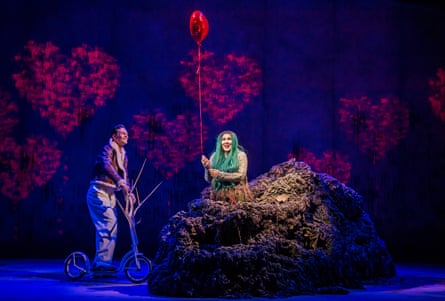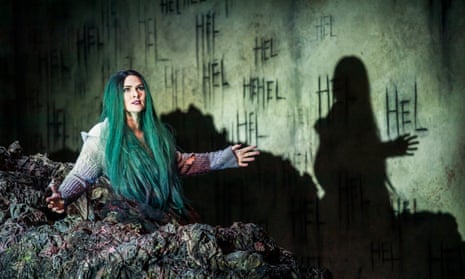A few years ago, I was sitting on the New York subway when a voice popped into my head. A sarcastic, teenage, yeah whatever, eye-rolling voice. She said, “You’d think after my brother the snake was born they’d have stopped at one.” I knew who was speaking. It was Hel, the Norse goddess of the dead, half-human, half-corpse, daughter of a god and a giantess, who Odin hurls into the Underworld and forces to rule the dead.
The whole plot of my novel The Monstrous Child came to me in that moment. I’ve always loved mythology, and Hel’s story seemed a great way to write about dysfunctional families and the turbulence and passion of adolescence. It was the first time I’d written a novel in the first person. While writing it, I knew it could be turned into an opera. Opera is so heightened, the perfect way to express the epic sweep of gods and giants, love and hate, jealousy and vengeance, as well as a young girl’s journey towards creating her own life.
However, believing I’d written an operatic book was one thing. Imagining that it would actually become an opera was quite another. It all started in 2013 (it’s true, opera takes for ever) when I was introduced to John Fulljames, then associate director of the Royal Opera House, at the interval of Die Fledermaus at the ENO. My beloved dog had died that day, and I was not feeling sociable. But I am forever grateful I did decide to go out that night, because John liked my Horrid Henry books and said I should contact him if I ever had an idea for an opera. I remember thinking, “Yeah, right.” I knew almost nothing about opera, and wasn’t a fan. Another bit of luck was that I knew the composer, Gavin Higgins, through a mutual friend. I loved his music, its harshness and energy and violence, but also its lyrical, emotional and theatrical qualities. I gave him my manuscript in 2015 and, miraculously, our “Wagner for teens” was commissioned.
I was thrilled about creating something unlike anything I’d ever done. But I was also anxious. First I embarked on an opera crash course. I’ve now seen at least 60. (My favourite is Eugene Onegin.) I also asked every composer and librettist I knew for their top tips. (Thank you, Jonathan Dove, Jeremy Sams, George Stiles.) “Lots of vowels!” “Short lines!” “One syllable words!” “A few consonants to bite into!” “Don’t be operatic!”
I could do all that. I studied Anglo-Saxon, and have always loved alliteration, which works well in a libretto. I’ve read a lot of Norse sagas and Old English poetry, so I was familiar with their rhythms. I also wanted to capture the bleak quality of Norse mythology: its raven-dark frost worlds, its fire and ice, the wait for the inexorable End of Days and Ragnarök, the twilight of the gods.

Most important, I had to find a way to keep Hel’s acerbic voice. My solution was for her to talk to the audience – the newly arrived dead – much more than in most operas. She’s banished alive to Niflheim, the fog world of the dead, to spend eternity with rotting corpses. Without her flippant asides, it could be unbearable. Over 10 drafts, I struggled with making the opera work as drama and not just a monologue. I’ve also had to discover how to share Hel’s story with the music. The analogy I used was picture books. The words need to allow space for the illustrations. Of course, I made rookie mistakes. In a novel, it doesn’t matter if characters hang around silently while others are the main focus. Gavin once pointed out that I had seven people on stage for ages and only two were singing. Truthfully, I’d forgotten the others were there. Hello, chorus of the gods.
We’re telling a mythic story of the beginning and end of the world, with an angry, lovelorn, regal, funny and depressed teen as our guide. I can’t give too much away, but director Tim Sheader and designer Paul Wills have come up with some brilliantly theatrical ideas that I never imagined while I was writing. Oh. One more thing. It’s an opera cliche that the heroine dies at the end. Let’s just say that a woman will be the last one standing in The Monstrous Child.
